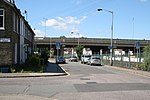Wandle Park, Croydon

Wandle Park is an 8.5-hectare (21-acre) park located in the Broad Green Ward of Croydon, south London, England. It was opened in 1890 by the Mayor of Croydon. The site is protected by Fields in Trust through a legal "Deed of Dedication" safeguarding the future of the space as public recreation land for future generations to enjoy.The River Wandle flows through the park. Between 1967 and 2012 this was in an underground culvert which was constructed by Croydon Council. The park used to contain a boating lake which dried up and was filled in.The park is used by many people and is popular with dog walkers, footballers, joggers, skateboarders and families. The park is easily accessible by public transport using Wandle Park tram stop. The park has a 'Friends Group' of local residents and park users that are working with Croydon Council to improve the park.
Excerpt from the Wikipedia article Wandle Park, Croydon (License: CC BY-SA 3.0, Authors, Images).Wandle Park, Croydon
Kemble Road, London Waddon (London Borough of Croydon)
Geographical coordinates (GPS) Address Nearby Places Show on map
Geographical coordinates (GPS)
| Latitude | Longitude |
|---|---|
| N 51.374444444444 ° | E -0.11138888888889 ° |
Address
Kemble Road
CR0 4JP London, Waddon (London Borough of Croydon)
England, United Kingdom
Open on Google Maps










